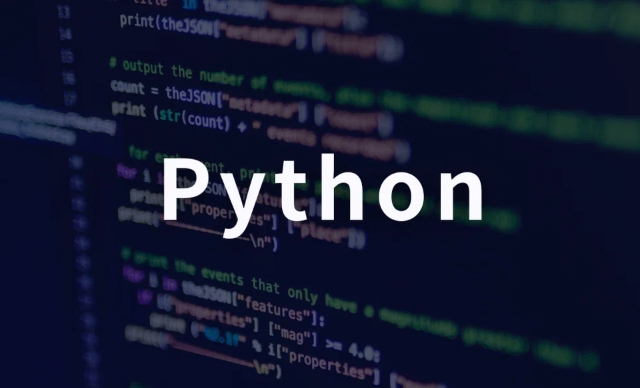 Backend Development
Backend Development
 Python Tutorial
Python Tutorial
 Building Recommendation Engines with Python Surprise Library
Building Recommendation Engines with Python Surprise Library
This article describes how to use Python's Surprise library to build a basic recommendation system. First, load the scoring data and perform pre-processing; second, select a suitable collaborative filtering algorithm (such as SVD) to train the model and evaluate the effect; then write a function to generate a user-personalized recommendation list; finally, use parameter tuning to improve the accuracy of the model. The steps are clear and suitable for introductory practice.

Recommendation systems are an indispensable part of modern applications, such as the "Guess You Like" for e-commerce platforms and the "Personalized Recommendations" for video platforms. Although relatively lightweight, Python's Surprise library is very suitable for getting started and quickly implementing recommended models for collaborative filtering classes. Let’s start from a few actual needs and talk about how to use Surprise to build a basic recommendation engine.

Data preparation: Load your rating data
Surprise supports loading data from a pandas DataFrame in local files or in memory. The most common one is the user-item rating list (User-ID, Item-ID, Rating). You can test it with built-in datasets or use your own data.
from surprise import Dataset
from surprise import Reader
import pandas as pd
# Suppose you have a DataFrame like this:
data = pd.DataFrame({
'userID': [1, 1, 2, 2, 3],
'itemID': [101, 102, 101, 103, 102],
'rating': [4, 5, 3, 4, 2]
})
reader = Reader(rating_scale=(1, 5))
dataset = Dataset.load_builtin('ml-100k') # Built-in MovieLens data# Or use custom data:
data = Dataset.load_builtin(data, reader=reader)Note: If your data is not normalized or the scope is not uniform, remember to process the scoring field in advance.

Algorithm selection: Choose a suitable collaborative filtering method
Surprise provides a variety of collaborative filtering algorithms, commonly used ones include:
-
KNNBasic: User-CF or Item-CF -
SVD: Matrix decomposition, suitable for implicit feature modeling -
SVDpp: An improved version of SVD, considering implicit feedback -
NMF: Non-negative matrix decomposition, suitable for sparse scoring data
For example, use SVD:

from surprise import SVD from surprise.model_selection import train_test_split trainset, testset = train_test_split(dataset, test_size=0.25) model = SVD() model.fit(trainset) predictions = model.test(testset)
The model effect can be evaluated based on the RMSE metric:
from surprise import accuracy accuracy.rmse(predictions) # Output RMSE value
Beginners are advised to start with SVD, which performs stably in most cases.
Recommendation generation: Recommend items to users
After training the model, the next step is to generate recommendations. Surprise itself does not have a direct recommendation interface. You need to write a small function to predict the user's ratings of all unrated items and sort them by scores.
For example:
def get_top_n_recommendations(model, user_id, n=10):
# Get the item that the user has already scored user_ratings = trainset.ur[trainset.to_inner_uid(user_id)]
items_rated_by_user = set(iid for (iid, _) in user_ratings)
# Prediction score all_items = trainset.all_items()
predictions = []
for iid in all_items:
if iid not in items_rated_by_user:
predictions.append((iid, model.predict(uid=user_id, iid=iid).est))
# Sort Top-N
predictions.sort(key=lambda x: x[1], reverse=True)
return predictions[:n]Call method:
top_recs = get_top_n_recommendations(model, user_id=196, n=5) print(top_recs)
This function returns the recommended item ID and predicted score, which is suitable for displaying recommended results.
Adjusting participation in optimization: Make the model more accurate
Surprise supports GridSearchCV for parameter search, and can automatically find the optimal hyperparameter combination. For example:
from surprise.model_selection import GridSearchCV
param_grid = {
'n_epochs': [20, 30],
'lr_all': [0.005, 0.01],
'reg_all': [0.02, 0.1]
}
gs = GridSearchCV(SVD, param_grid, measures=['rmse'], cv=3)
gs.fit(data)
print(gs.best_params['rmse']) # View the best parametersIn addition, you can also try different scoring normalization methods and use cross-validation to improve stability.
Basically that's it. Using Surprise to recommend is not complicated, but there are several details that are easy to ignore, such as scoring range settings, cold start issues, recommended deduplication, etc. However, it is enough for the introduction or small-scale recommendation system development.
The above is the detailed content of Building Recommendation Engines with Python Surprise Library. For more information, please follow other related articles on the PHP Chinese website!

Hot AI Tools

Undress AI Tool
Undress images for free

Undresser.AI Undress
AI-powered app for creating realistic nude photos

AI Clothes Remover
Online AI tool for removing clothes from photos.

Clothoff.io
AI clothes remover

Video Face Swap
Swap faces in any video effortlessly with our completely free AI face swap tool!

Hot Article

Hot Tools

Notepad++7.3.1
Easy-to-use and free code editor

SublimeText3 Chinese version
Chinese version, very easy to use

Zend Studio 13.0.1
Powerful PHP integrated development environment

Dreamweaver CS6
Visual web development tools

SublimeText3 Mac version
God-level code editing software (SublimeText3)
 Polymorphism in python classes
Jul 05, 2025 am 02:58 AM
Polymorphism in python classes
Jul 05, 2025 am 02:58 AM
Polymorphism is a core concept in Python object-oriented programming, referring to "one interface, multiple implementations", allowing for unified processing of different types of objects. 1. Polymorphism is implemented through method rewriting. Subclasses can redefine parent class methods. For example, the spoke() method of Animal class has different implementations in Dog and Cat subclasses. 2. The practical uses of polymorphism include simplifying the code structure and enhancing scalability, such as calling the draw() method uniformly in the graphical drawing program, or handling the common behavior of different characters in game development. 3. Python implementation polymorphism needs to satisfy: the parent class defines a method, and the child class overrides the method, but does not require inheritance of the same parent class. As long as the object implements the same method, this is called the "duck type". 4. Things to note include the maintenance
 Explain Python generators and iterators.
Jul 05, 2025 am 02:55 AM
Explain Python generators and iterators.
Jul 05, 2025 am 02:55 AM
Iterators are objects that implement __iter__() and __next__() methods. The generator is a simplified version of iterators, which automatically implement these methods through the yield keyword. 1. The iterator returns an element every time he calls next() and throws a StopIteration exception when there are no more elements. 2. The generator uses function definition to generate data on demand, saving memory and supporting infinite sequences. 3. Use iterators when processing existing sets, use a generator when dynamically generating big data or lazy evaluation, such as loading line by line when reading large files. Note: Iterable objects such as lists are not iterators. They need to be recreated after the iterator reaches its end, and the generator can only traverse it once.
 How to handle API authentication in Python
Jul 13, 2025 am 02:22 AM
How to handle API authentication in Python
Jul 13, 2025 am 02:22 AM
The key to dealing with API authentication is to understand and use the authentication method correctly. 1. APIKey is the simplest authentication method, usually placed in the request header or URL parameters; 2. BasicAuth uses username and password for Base64 encoding transmission, which is suitable for internal systems; 3. OAuth2 needs to obtain the token first through client_id and client_secret, and then bring the BearerToken in the request header; 4. In order to deal with the token expiration, the token management class can be encapsulated and automatically refreshed the token; in short, selecting the appropriate method according to the document and safely storing the key information is the key.
 How to iterate over two lists at once Python
Jul 09, 2025 am 01:13 AM
How to iterate over two lists at once Python
Jul 09, 2025 am 01:13 AM
A common method to traverse two lists simultaneously in Python is to use the zip() function, which will pair multiple lists in order and be the shortest; if the list length is inconsistent, you can use itertools.zip_longest() to be the longest and fill in the missing values; combined with enumerate(), you can get the index at the same time. 1.zip() is concise and practical, suitable for paired data iteration; 2.zip_longest() can fill in the default value when dealing with inconsistent lengths; 3.enumerate(zip()) can obtain indexes during traversal, meeting the needs of a variety of complex scenarios.
 What are Python type hints?
Jul 07, 2025 am 02:55 AM
What are Python type hints?
Jul 07, 2025 am 02:55 AM
TypehintsinPythonsolvetheproblemofambiguityandpotentialbugsindynamicallytypedcodebyallowingdeveloperstospecifyexpectedtypes.Theyenhancereadability,enableearlybugdetection,andimprovetoolingsupport.Typehintsareaddedusingacolon(:)forvariablesandparamete
 What are python iterators?
Jul 08, 2025 am 02:56 AM
What are python iterators?
Jul 08, 2025 am 02:56 AM
InPython,iteratorsareobjectsthatallowloopingthroughcollectionsbyimplementing__iter__()and__next__().1)Iteratorsworkviatheiteratorprotocol,using__iter__()toreturntheiteratorand__next__()toretrievethenextitemuntilStopIterationisraised.2)Aniterable(like
 Explain Python assertions.
Jul 07, 2025 am 12:14 AM
Explain Python assertions.
Jul 07, 2025 am 12:14 AM
Assert is an assertion tool used in Python for debugging, and throws an AssertionError when the condition is not met. Its syntax is assert condition plus optional error information, which is suitable for internal logic verification such as parameter checking, status confirmation, etc., but cannot be used for security or user input checking, and should be used in conjunction with clear prompt information. It is only available for auxiliary debugging in the development stage rather than substituting exception handling.
 How to test an API with Python
Jul 12, 2025 am 02:47 AM
How to test an API with Python
Jul 12, 2025 am 02:47 AM
To test the API, you need to use Python's Requests library. The steps are to install the library, send requests, verify responses, set timeouts and retry. First, install the library through pipinstallrequests; then use requests.get() or requests.post() and other methods to send GET or POST requests; then check response.status_code and response.json() to ensure that the return result is in compliance with expectations; finally, add timeout parameters to set the timeout time, and combine the retrying library to achieve automatic retry to enhance stability.





